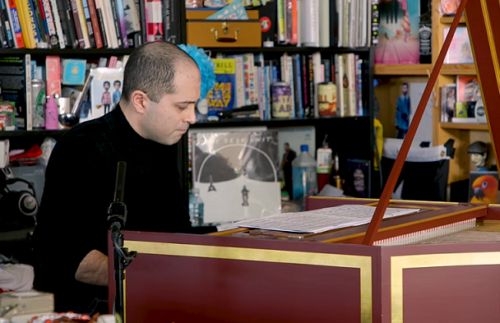 United States Various: Mahan Esfahani (harpsichord). Presented by Cal Performances, Hertz Hall, University of California, Berkeley, 2.4.2023. (HS)
United States Various: Mahan Esfahani (harpsichord). Presented by Cal Performances, Hertz Hall, University of California, Berkeley, 2.4.2023. (HS)

Byrd – ‘Lachrimae Pavan’ (after Dowland); ‘The Bells’; ‘Fantasia’ MB27
J. S. Bach – English Suite No.3 in G minor, BWV808
Brett Dean – ‘ByrdSong Studies’ (U.S. premiere)
Scarlatti – Sonatas in F major, Kk106, Allegro; in F major, Kk.107, Allegro; in F minor, Kk.466, Andante moderato; in D minor, Kk.552, Andante; in C minor, Kk.116, Allegro; in D minor, Kk.32, Aria
In 2021, during the pandemic when live concerts stopped abruptly, Cal Performances produced a series of video recitals by artists who were on the schedule before it was torn up. Those videos from the performing arts arm of the University of California, Berkeley, brought a few rays of sunlight to what felt like a parched desert. Among them was a mesmerizing journey through Bach’s Goldberg Variations by harpsichordist Mahan Esfahani (for review click here).
Esfahani’s recital in Hertz Hall, a 678-seat venue that almost felt too big for the quiet instrument, revealed a wider range of harpsichord mastery. There was Bach, of course, this time the English Suite No.3, but the program also reached back to the sixteenth- and seventeenth-century English composer William Byrd, and to music of our own times in a Byrd-inspired piece by Australian Brett Dean.
The delight of the program, however, came from a collection of sonatas by Domenico Scarlatti. A contemporary of J. S. Bach, Scarlatti produced 555 single-movement sonatas, usually around 5 minutes in duration, that exploited ways to get music out of a double keyboard attached to plucked strings that were entirely different from Bach’s. Rather than weaving irresistible counterpoint, Scarlatti’s keyboard music focused on straightforward melody-and-accompaniment that laid the groundwork for what we now think of as the Classical Style.
The set started with two sonatas marked allegro: the Sonata in F major Kk.106, a playful, bouncy romp that showed off Esfahani’s rhythmic vitality and dry wit, followed by the sparkle and lightweight effusiveness of Kk.107. The tempo slowed only a bit for Kk.466 in F minor (Andante moderato), which brought out a soulfulness and legato few harpsichordists can achieve and settled into a semi-contrapuntal groove in Kk.552 in D minor (Andante).
K.115 in C minor (Allegro) traveled in feverish hand-crossing as Esfahani skipped through its challenges with refreshing élan, and he finished with the sweet, poignant aria of Kk.32 in D minor, one of Scarlatti’s most-played sonatas. Here again, this harpsichordist’s ability to transform the plucked strings of the instrument into liquid legato paid dividends.
The opening gambit for the afternoon comprised three keyboard works by William Byrd. Adapted by Byrd from John Dowland’s famous set of teary music, ‘Lachrimae Pavan’ dripped with extravagant ornamentation around a steady and expressive rendering of the theme. It not only introduced Esfahani’s technical mastery but pulled the many notes together into something that moved along smoothly. ‘The Bells’ culminated in impressively rapid traversals up and down the keyboard, and ‘Fantasia’ finished with torrents of complex density, a reminder of how Byrd engineered a different style for keyboard from his signature slow-moving polyphony in vocal works.
After intermission came the U.S. premiere of ‘ByrdSong Studies’. In this 2021 piece, Dean, composer in residence at the London Philharmonic Orchestra, quotes and expands on Byrd’s Earl of Salisbury pavane, interrupting with renderings of actual bird-song à la twentieth-century French composer Olivier Messiaen. And it actually felt more natural on the harpsichord than on piano.
As it veered from Byrd to bird, Dean’s music kept both Esfahani and the listening audience on its toes for eight minutes. At the end, the sound system adds a snippet of a choir singing the Kyrie from a Byrd mass. The harpsichord’s comments became softer and more subdued as the piece settled into a gentle close.
In the Bach suite, Esfahani brought lyric suppleness to the rhythms and actual legato to the dance music, especially in the delicate rendering of the second gavotte. The final gigue, rather than bouncing crisply, had a sly sheen to it that set it apart from other harpsichordists’ interpretations.
For an encore, Esfahani turned to György Ligeti’s 1968 ‘Continuum’, a piece that swings from sweetness to clattery dissonance. It was included in a set of Byrd’s music (different ones from this program’s choices) recorded at Wigmore Hall in London a decade ago and released on disc in 2014. The composer’s brash wit came through brilliantly as perpetual-motion trills and tightly wound figures expanded and contracted before finishing in a whisper. A jolt after all the Baroque beauty, it sent an invigorated audience into the cool, sunny, early evening.
Harvey Steiman
